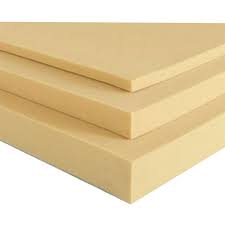
The Versatility and Benefits of Rigid Polyurethane Foam
Rigid polyurethane foam is a versatile material that has found widespread applications across various industries due to its exceptional properties and benefits. This foam is created by mixing two liquid components – polyol and isocyanate – which react to form a rigid, closed-cell structure.
Insulation Properties
One of the key advantages of rigid polyurethane foam is its excellent insulation properties. It has a high thermal resistance, making it an ideal choice for insulating buildings, refrigeration units, and pipelines. The closed-cell structure of the foam traps air, providing superior thermal efficiency compared to other insulation materials.
Strength and Durability
Rigid polyurethane foam is known for its strength and durability. It can withstand heavy loads without deforming, making it suitable for structural applications such as sandwich panels, doors, and roofing systems. The foam’s ability to maintain its shape and structural integrity over time contributes to its long lifespan.
Lightweight Nature
Despite its strength, rigid polyurethane foam is lightweight, making it easy to handle and install. Its low density also helps reduce the overall weight of structures without compromising on performance. This characteristic makes it an attractive choice for applications where weight reduction is crucial.
Chemical Resistance
Rigid polyurethane foam exhibits good resistance to chemicals, making it suitable for use in environments where exposure to corrosive substances is a concern. This property enhances the longevity of structures and equipment insulated or constructed using this material.
Sustainability
In addition to its performance benefits, rigid polyurethane foam is also environmentally friendly. Many formulations now incorporate bio-based or recycled content, reducing the carbon footprint of the material. Its energy-saving properties contribute to lower greenhouse gas emissions during the lifecycle of buildings and products using this foam.
Overall, rigid polyurethane foam stands out as a versatile material that offers a combination of insulation efficiency, strength, lightweight design, chemical resistance, and sustainability. Its wide-ranging applications make it a preferred choice for industries looking for high-performance solutions that meet both technical requirements and environmental standards.
“Exploring the Key Properties of Rigid Polyurethane Foam”
“The Role of Rigid Polyurethane Foam in Insulation Applications”
4.
- What is rigid polyurethane foam?
- What are the key properties of rigid polyurethane foam?
- How is rigid polyurethane foam used in insulation?
- What are the advantages of using rigid polyurethane foam in construction?
- Is rigid polyurethane foam environmentally friendly?
What is rigid polyurethane foam?
Rigid polyurethane foam is a specialized material known for its exceptional thermal insulation properties and structural integrity. It is created by combining polyol and isocyanate components, which undergo a chemical reaction to form a rigid, closed-cell structure. This foam is widely used in various industries for applications such as building insulation, refrigeration units, and composite panels due to its ability to provide high thermal resistance and strength while remaining lightweight. Rigid polyurethane foam offers a versatile solution for enhancing energy efficiency, durability, and sustainability in construction and manufacturing processes.
What are the key properties of rigid polyurethane foam?
Rigid polyurethane foam possesses several key properties that make it a highly desirable material for various applications. One of its primary attributes is its exceptional insulation capability, thanks to its high thermal resistance and closed-cell structure that effectively traps air. This foam also exhibits impressive strength and durability, enabling it to withstand heavy loads without compromising its structural integrity. Additionally, rigid polyurethane foam is lightweight, making it easy to handle and install while reducing overall weight in structures. Its chemical resistance further enhances its suitability for use in diverse environments. Overall, the combination of insulation efficiency, strength, lightweight nature, and chemical resistance makes rigid polyurethane foam a versatile material with a wide range of benefits for different industries.
How is rigid polyurethane foam used in insulation?
Rigid polyurethane foam is commonly used in insulation due to its exceptional thermal efficiency and versatility. In insulation applications, rigid polyurethane foam is typically applied as panels or spray foam to create a continuous layer that acts as a barrier against heat transfer. The closed-cell structure of the foam traps air within its cells, effectively reducing heat flow through conduction. This property helps maintain indoor temperatures by minimizing heat loss in winter and heat gain in summer. Rigid polyurethane foam insulation is widely used in buildings, refrigeration units, pipelines, and appliances to enhance energy efficiency, reduce heating and cooling costs, and create comfortable living or working environments.
What are the advantages of using rigid polyurethane foam in construction?
Rigid polyurethane foam offers several advantages when used in construction applications. One key benefit is its exceptional insulation properties, providing high thermal resistance that helps in maintaining indoor comfort and reducing energy consumption for heating and cooling. Additionally, the lightweight nature of rigid polyurethane foam makes it easy to handle and install, contributing to faster construction processes. The material’s strength and durability ensure long-term structural integrity, making it suitable for various building components such as walls, roofs, and floors. Rigid polyurethane foam also offers excellent fire resistance and sound insulation properties, enhancing the safety and comfort of building occupants. Overall, the use of rigid polyurethane foam in construction results in energy-efficient, durable, and sustainable structures that meet modern performance standards.
Is rigid polyurethane foam environmentally friendly?
Rigid polyurethane foam is considered environmentally friendly due to its energy-saving properties and sustainability features. Many formulations of rigid polyurethane foam now incorporate bio-based or recycled content, reducing the material’s carbon footprint. The high thermal efficiency of rigid polyurethane foam contributes to energy conservation by reducing heating and cooling requirements in buildings, ultimately leading to lower greenhouse gas emissions. Additionally, the durability and long lifespan of rigid polyurethane foam help minimize waste generation, making it a sustainable choice for various applications where environmental impact is a concern.
